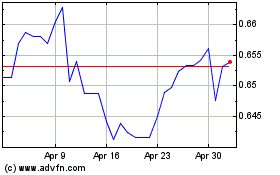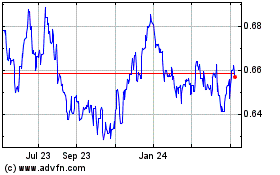Dollar Falls As U.S. Yield Curve Inverts Again
August 15 2019 - 4:18AM
RTTF2
The U.S. dollar declined against its major counterparts in the
European session on Thursday, as the U.S. yield curve inverted for
the second consecutive day, with the yield on 10-year U.S. Treasury
bonds falling below 2-year yields amid fears over economic
downturn.
The benchmark yield on 10-year note fell 1.53 percent, while
that of 2-year equivalent was down by 1.51 percent. Yields move
inversely to bond prices.
The spread between the 2-year note and the 10-year note
steepened further, stocking fears over an upcoming recession.
The yield on 30-year note slumped to a record low of 1.95
percent.
The sell-off in European shares intensified after China
threatened retaliation against U.S. imposing duties on its goods
from September 1 date.
China announced that it would take unspecified "necessary
countermeasures, if Washington imposes 10 percent tariffs on
additional $300 billion of Chinese imports on the proposed
date.
Amid heightened trade worries, analysts believe that the Federal
Reserve is likely to cut short-term interest rates to support the
economy.
Investors await reports on weekly jobless claims, retail sales,
industrial production, regional manufacturing activity, business
inventories and homebuilder confidence for more direction.
The currency held steady against its major counterparts in the
Asian session, excepting the euro.
The greenback dropped to 105.70 against the yen, from a 2-day
high of 106.77 it touched at 2:30 am ET. The greenback is seen
finding support around the 102.00 level.
Final data from the Ministry of Economy, Trade and Industry
showed that Japan's industrial production declined less than
initially estimated in June.
Industrial production fell 3.3 percent month-on-month compared
to the initial estimate of 3.6 percent decrease.
The greenback edged lower to 0.9722 against the franc, after
rising to 0.9757 at 2:30 am ET. The greenback is likely to
challenge support around the 0.96 level.
The U.S. currency depreciated to a 6-day low of 1.2114 against
the pound from Wednesday's closing value of 1.2053. If the
greenback extends drop, 1.23 is possibly seen as its support
level.
Data from the Office for National Statistics showed that U.K.
retail sales grew unexpectedly in July.
The retail sales volume grew 0.2 percent in July from June when
sales advanced 0.9 percent. Sales were forecast to drop 0.2
percent.
The greenback that closed Wednesday's trading at 1.1138 versus
the euro dropped to 1.1159. The greenback is likely to face support
around the 1.13 level.
On the flip side, the greenback recovered to 0.6427 against the
kiwi and 0.6765 against the aussie, from its early lows of 0.6459
and 0.6790, respectively. The next possible resistance for the
greenback is seen around 0.63 against the kiwi and 0.64 against the
aussie.
The greenback appreciated to an 8-day high of 1.3330 against the
loonie, compared to 1.3319 hit late New York Wednesday. Next key
resistance for the greenback is seen around the 1.35 region.
Looking ahead, Canada existing home sales for July, U.S. weekly
jobless claims for the week ended August 10, retail sales and
industrial production for July, New York Fed's empire manufacturing
index and NAHB housing market index for August are scheduled for
release in the New York session.
AUD vs US Dollar (FX:AUDUSD)
Forex Chart
From Mar 2024 to Apr 2024

AUD vs US Dollar (FX:AUDUSD)
Forex Chart
From Apr 2023 to Apr 2024
